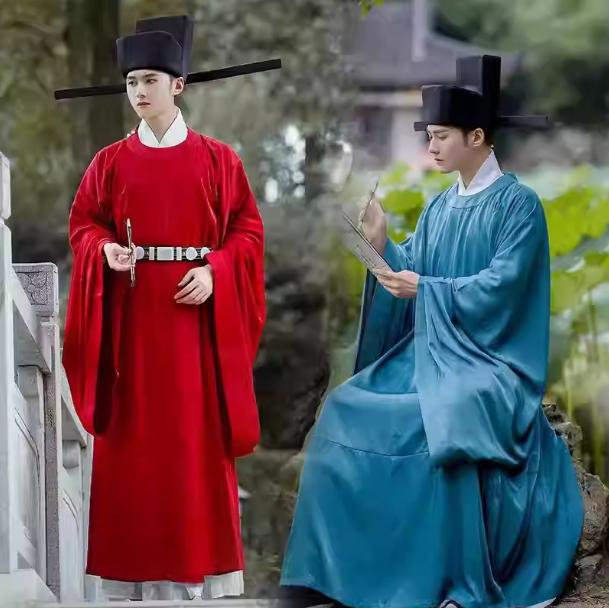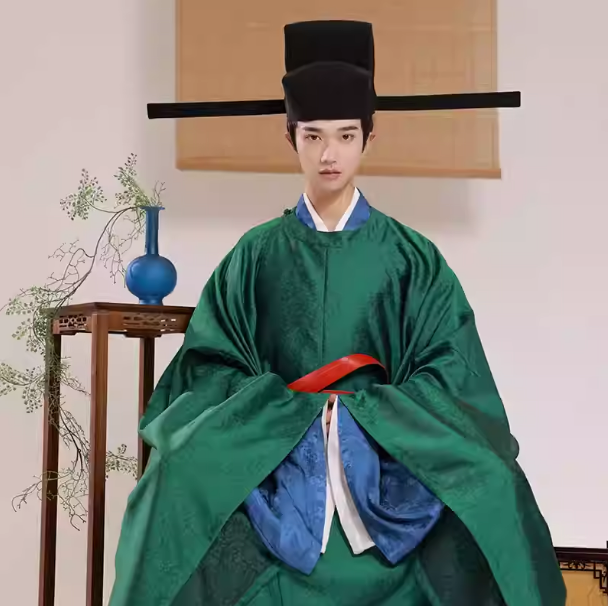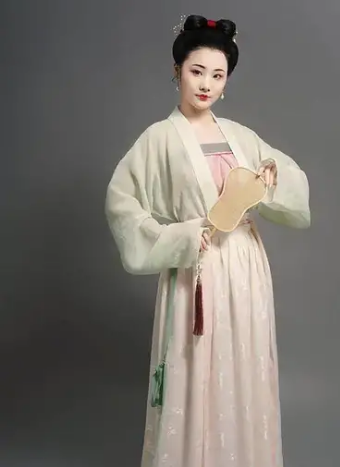Materials and Textiles
In Song Dynasty official attire, the choice of materials and textiles played a pivotal role in defining the opulence and sophistication of the clothing. The use of luxurious silk and a diverse array of weaves and patterns were central to this distinctive style.
Utilization of Luxurious Silk
Silk, with its smooth texture and lustrous sheen, stood as the primary fabric of choice for crafting official garments. Song Dynasty officials and nobility adorned themselves in silk robes that showcased not only their status but also the exceptional craftsmanship of the era. Silk production reached new heights during this period, with artisans mastering the art of silk weaving to create fabrics that were both visually stunning and incredibly comfortable.

Variety in Weaves and Patterns
The Song Dynasty prided itself on the diverse weaves and intricate patterns that adorned its official clothing. Damask, known for its reversible patterns, was favored for its timeless elegance. Brocade, characterized by raised and ornate designs, added depth and richness to attire. Delicate gauze weaves, renowned for their sheer and airy qualities, were chosen for lighter garments. These various weaves allowed for a wide spectrum of design possibilities, with patterns ranging from auspicious symbols to elaborate landscapes. Such diversity in textiles demonstrated the dynasty’s commitment to aesthetics and craftsmanship, offering officials a means of expressing their individuality and style.
The utilization of sumptuous silk and the rich assortment of weaves and patterns in Song Dynasty official clothing epitomized an era of sartorial excellence. These choices not only underscored the dynasty’s emphasis on visual appeal but also highlighted the exceptional skill of textile artisans during that period. For more insights, you can explore Silk in Chinese culture on Wikipedia.
Symbolism and Colors
In Song Dynasty official attire, colors and symbolic motifs held profound significance, conveying not only aesthetic beauty but also intricate messages of rank, virtue, and cultural values.
Colors Representing Rank
The choice of colors in Song Dynasty official clothing was not arbitrary; it conveyed the wearer’s rank and position within the imperial court through a carefully selected palette:
- Yellow: Exclusively for the emperor, symbolizing supreme authority. Dragon patterns adorned the emperor’s robes.
- Blue and Green: Denoted harmony, growth, and virtue, often worn by high-ranking officials.
- Red and Purple: Signified nobility and auspiciousness, with purple for officials and red for noblewomen.
- Black: Associated with scholars and intellectuals, representing depth of character and seriousness.
- White: Symbolized purity and integrity, chosen by morally upright officials.
- Other Colors: Gray represented modesty, while brown conveyed frugality.
Symbolic Motifs
Song Dynasty officials meticulously incorporated symbolic motifs into their clothing, each carrying distinct meanings:
- Dragons: Reserved for the emperor, symbolized imperial power, strength, and good fortune.
- Phoenix: Worn by empresses and noblewomen, representing beauty and grace.
- Clouds and Waves: Signified auspiciousness, longevity, and the cyclical nature of life.
- Mountains and Streams: Emphasized harmony with nature and the virtue of humility.
- Floral Patterns: Peonies and lotuses symbolized prosperity, purity, and nobility.
- Animal Motifs: Cranes and turtles brought connotations of longevity and wisdom.
The use of colors and symbolic motifs in Song Dynasty official clothing not only added visual splendor but also conveyed a rich tapestry of cultural values and hierarchical distinctions. These elements transformed attire into a medium for storytelling and cultural expression. To delve deeper, explore Chinese clothing symbolism on Wikipedia.
Design Elements
In Song Dynasty official clothing, meticulous design elements were paramount, contributing to the attire’s exquisite aesthetics and cultural significance.
Intricate Embroidery
Elaborate embroidery was a hallmark of Song Dynasty official attire, showcasing the highest levels of craftsmanship:
- Silk Threads: Artisans used fine silk threads to create intricate patterns and motifs. These threads were often dyed using natural pigments to achieve a vibrant color palette.
- Imagery: Embroidery depicted a wide range of subjects, including dragons, phoenixes, flowers, and landscapes. Each motif held symbolic meaning, conveying virtue, prosperity, and cultural ideals.
- Techniques: Various embroidery techniques, such as satin stitch, chain stitch, and couching, were employed to achieve different textures and effects. Some garments featured raised embroidery for added depth.
- Positioning: The placement of embroidery was deliberate. High-ranking officials often had dragon patterns on their chest, while lower-ranking officials had them on their shoulders. This placement reflected their status.
Distinctive Cuts
Song Dynasty official attire was known for its distinctive cuts and silhouettes, contributing to its elegance and uniqueness:
- Robes: The typical official robe, known as a “pao,” had a straight-cut shape with wide sleeves. The length and width of the sleeves, as well as the overall length of the robe, varied based on rank.
- Collars: Collar styles varied, with some featuring upright collars while others had flat collars. Collar width and shape also indicated rank.
- Fastenings: Garments were fastened using cloth buttons or fabric ties, with the number and style of fastenings denoting the wearer’s status.
- Layering: Officials often wore several layers of clothing, with each layer revealing subtle details of their rank and role.
The combination of intricate embroidery and distinctive cuts in Song Dynasty official attire resulted in garments that were not only visually striking but also deeply symbolic. These design elements celebrated the artistry of the time and conveyed a rich tapestry of cultural and hierarchical meanings. To explore further, you can refer to Chinese embroidery and Chinese clothing on Wikipedia.

Gender Differences in Song Dynasty Attire
During the Song Dynasty, distinctive attire for men and women highlighted gender-specific styles, reflecting societal norms and cultural evolution.
Male vs. Female Attire
Men’s Attire:
- Men commonly donned loose-fitting robes known as “pao” or “changshan,” featuring a cross-collar design and fastened with buttons.
- These robes prioritized practicality, allowing for ease of movement, with sober colors like black, blue, and brown prevailing.
- Men’s attire included essential accessories like belts and headwear, with variations based on rank and occasion.
Women’s Attire:
- Women’s clothing, in contrast, exhibited more intricate and colorful designs.
- Popular garments included the “ruqun” and “qixiong ruqun,” combining layered skirts and blouses.
- Vibrant silk fabrics and delicate embroidery were prominent, often featuring floral motifs, auspicious symbols, and intricate patterns.
- Femininity and elegance were accentuated through the use of hair ornaments, jewelry, and accessories.
Evolution of Women’s Dress
Early Period:
- In the early Song Dynasty, women’s clothing retained certain elements of Tang Dynasty fashion, such as high collars and long sleeves.
- The emphasis was on simplicity and elegance, with a preference for subdued colors and minimalistic designs.
Mid to Late Period:
- As the dynasty progressed, women’s attire became increasingly elaborate, featuring a broader range of fabrics and colors.
- The “qixiong ruqun” style gained popularity during this era, characterized by a high-waisted belt.
- Elaborate embroidery and decorative motifs enriched women’s clothing.
Influences of Culture and Society:
- Cultural factors, including the rise of Confucianism and Neo-Confucianism, played a pivotal role in shaping changes in women’s clothing.
- These ideologies emphasized modesty and restraint, influencing clothing styles.
Foot Binding:
- Foot binding, a prevalent practice during the Song Dynasty, impacted women’s footwear and mobility, reflecting cultural norms.
Gender distinctions in Song Dynasty attire celebrated practicality and aesthetics for men and women, respectively. The evolution of women’s dress was molded by cultural influences and shifting ideologies, resulting in a diverse array of styles throughout the dynasty’s history. For more in-depth information, please refer to Song Dynasty on Wikipedia.

Regulations and Dress Codes in the Song Dynasty
The Song Dynasty featured stringent regulations and dress codes that governed attire, with a clear differentiation based on rank and social status. These regulations exemplified the Confucian values and hierarchical structure of society.
Stringent Official Rules
Imposed Sumptuary Laws:
- The Song Dynasty implemented sumptuary laws to control individuals’ attire, based on their income and social rank.
- These laws aimed to maintain social order and curb excessive spending on clothing.
- Violations of these laws could result in fines or penalties.
Rank-Based Dressing:
- Specific guidelines for clothing existed for each social class and official rank.
- Guidelines dictated the choice of colors, fabrics, and designs to signify one’s societal position.
- Notably, officials and scholars had distinct attire, including the “zhaoshan” for scholars and “mandarin squares” for officials.
Court Attire Requirements:
- Court officials were obliged to don formal court attire when fulfilling official duties.
- Court attire featured intricate embroidery and specific colors signifying rank.
- The attire exuded opulence, reflecting the significance of one’s role in the government.
Rank-Differentiating Factors
Color Symbolism:
- Color played a pivotal role in denoting social status.
- Yellow, for instance, was reserved exclusively for the emperor, while blue and green were associated with lower ranks.
- Commoners typically favored more muted colors.
Headwear and Accessories Significance:
- Hats and headwear held great importance in Song Dynasty attire.
- The style and embellishments of headwear varied based on one’s rank and the occasion.
- Accessories, such as belts, jewelry, and waistbands, were also employed to distinguish social status.
Practicality vs. Ornamentation:
- While officials adhered rigorously to dress codes, commoners prioritized practicality in their clothing.
- Commoners’ attire was less ornate, focusing on comfort and durability.
- Attire differences underscored the distinct lifestyles of various social strata.
Impact of Regulations
- These regulations underscored the hierarchical nature of Song Dynasty society.
- They reinforced core Confucian values, namely modesty and deference to authority.
- Clothing served as a visual representation of one’s role and standing within society.
In summary, the Song Dynasty’s regulations and dress codes played a pivotal role in upholding social order and reinforcing Confucian values. Attire served as a potent symbol of rank and status, with rigorous guidelines ensuring individuals conformed to their designated societal roles. For further information, please consult Song Dynasty Clothing on Wikipedia.

Ceremonial vs. Everyday Attire in the Song Dynasty
Attire in the Song Dynasty displayed a stark contrast between ceremonial grandeur and practical everyday wear, reflecting the complexity of this historical era.
Grand Ceremonial Dress
Elaborate Robes:
- Ceremonial attire in the Song Dynasty consisted of elaborate robes made from luxurious silk.
- These robes featured intricate embroidery, often depicting auspicious motifs and symbols.
- The emperor’s ceremonial robe, in particular, was adorned with dragons, symbolizing imperial power.
Headdresses and Accessories:
- Ceremonial dress included ornate headdresses with phoenix or dragon motifs.
- Accessories such as jade pendants and belts were intricately designed.
- The use of gemstones and precious metals was not uncommon, highlighting opulence.
Strict Color Symbolism:
- Ceremonial attire adhered to strict color symbolism, with specific colors denoting rank and status.
- Bright and vivid colors, such as yellow and red, were reserved for the emperor and high-ranking officials.
- Gold thread and intricate patterns further distinguished ceremonial attire.
Practical Daily Wear
Simplicity and Comfort:
- Everyday attire in the Song Dynasty was characterized by simplicity and comfort.
- Commoners and scholars favored clothing made from plain silk or cotton.
- The emphasis was on functionality, allowing ease of movement for daily tasks.
Minimal Embellishments:
- Daily wear featured minimal embellishments and embroidery, focusing on durability.
- Practicality was paramount, with subdued colors like blue, green, and brown being prevalent.
- Clothing design prioritized ease of maintenance.
Distinctive Cuts:
- The cut of everyday clothing was more straightforward, with loose-fitting robes and trousers.
- These designs facilitated practicality for various activities, such as farming or scholarly pursuits.
- Headwear was less ornate, often featuring simple hats or turbans.
Significance and Transition
- The stark contrast between ceremonial and everyday attire highlighted the importance of rituals and hierarchy in the Song Dynasty.
- Ceremonial dress symbolized authority, tradition, and reverence for the emperor and the court.
- Everyday wear, on the other hand, embodied pragmatism and reflected the lifestyle of commoners and scholars.
In summary, the Song Dynasty’s clothing culture encompassed both grand ceremonial dress, rich in symbolism and opulence, and practical daily wear designed for functionality and comfort. This duality in attire showcased the multifaceted nature of society during this historical period. For further information, please refer to Song Dynasty Clothing on Wikipedia.